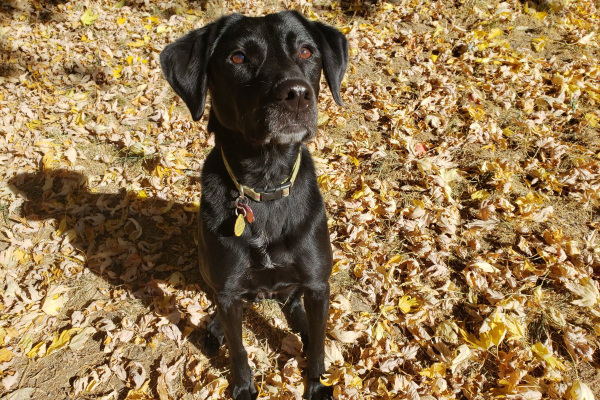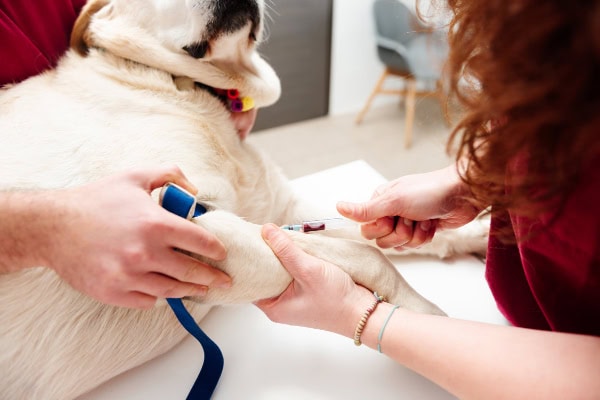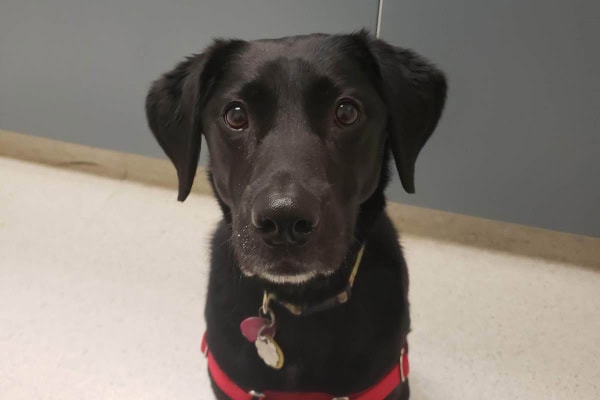Finding out your four-legged companion has a brain tumor in dogs is distressing whether you are a dog parent or a veterinarian. Dr. Jessica Harris, friend of integrative veterinarian Dr. Julie Buzby, knows that pain all too well because her own dog, Dixie, was diagnosed with a brain tumor. To help guide you through this difficult diagnosis, Dr. Harris shares her dog’s story and discusses the types, symptoms, diagnosis, treatment, and prognosis for brain tumors in dogs.

Several years ago, my black Labrador, Dixie, started acting weird. Sometimes she was suddenly aggressive towards my other dog, who was her best friend. Previously, they had always been inseparable. She also was barking at random walls as if there was something there.
At first, I suspected she was developing canine cognitive dysfunction so I started pursuing different brain stimulation toys and other treatment options.
However, a few weeks later, she started to have seizures and developed a wobbly gait. I took Dixie to the closest specialty hospital, where my friend happened work as a neurologist. She ordered multiple tests for Dixie, including blood work and advanced imaging. After all the tests were completed, my friend pulled me aside and told me that Dixie had a brain tumor.
We talked about what the diagnosis of a brain tumor meant for Dixie and how we should proceed. There were a lot of factors to consider and a lot of information to process since brain tumors in dogs can vary from one dog to another and one type of brain tumor to another.
Because I remember how overwhelmed I felt having this discussion with my friend (even as a veterinarian), I wanted to share some information about the symptoms, types, treatments, and prognosis for dogs with brain tumors.
What are brain tumors in dogs?
The term “brain tumors in dogs” encompasses any sort of abnormal growth of tissue in a dog’s brain. They are usually categorized as either primary brain tumors or secondary brain tumors in both dogs and cats. Tumors that originate from the brain itself or the membranes that cover the brain are called primary brain tumors. Some examples include:
- Meningioma or meningeal sarcoma
- Lymphoma
- Histiocytic sarcoma
- Cranial nerve tumors
- Germ cell tumors
- Pituitary tumors
On the other hand, secondary brain tumors spread to the brain (i.e. metastasize) from other parts of the body. Or they come from tumors of the nose or head that invade the brain. There are many different secondary brain tumors, but some of the most common ones are:
- Hemangiosarcoma in dogs
- Osteosarcoma in dogs
- Chondrosarcoma
- Nasal adenocarcinoma (a type of nasal tumor in dogs)
- Melanoma
- Adenocarcinomas from the mammary glands or kidneys
- Prostate cancer in dogs (adenocarcinoma specifically)
Both primary and secondary brain tumors can have devastating effects as they compress and destroy brain tissue.
What causes brain tumors in dogs?
As is the case with many tumors, the exact cause of brain tumors in dogs is unknown. However, there do seem to be some breed predispositions. The following dog breeds are more likely to develop brain tumors:
- Brachycephalic breeds (i.e. dogs with a flat face) like Boston Terriers, English Bulldogs, French Bulldogs, and Mastiffs—These dogs are most likely to develop glial cell tumors and pituitary gland tumors.
- Boxers
- Labrador Retrievers
- Shetland Sheepdogs
- Miniature Schnauzers
- Doberman Pinschers
- Dogs with narrow heads and longer noses like Golder Retrievers and Collies—These dogs are most likely to develop meningiomas.
Additionally, brain tumors in dogs occur most often in older dogs who are over the age of 5 years.
What are the common types of brain tumors in dogs?
Knowing what type of brain tumor your dog has can help you know what symptoms to monitor for, how the disease may progress, and which treatment options would be the best. Therefore, it is important to be aware of some of the most common types of brain tumors in dogs.
Meningiomas
Meningiomas are the most common primary brain tumors in dogs. In a Journal of Veterinary Medical Science study of brain tumors in dogs, meningiomas accounted for 50.9% of all primary brain tumors. Meningiomas occur most often in large, older dogs (around 12 to 14 years old) who have narrow heads and longer noses, such as Golden Retrievers and Collies. These tumors are usually slow-growing and can be malignant. The most common symptom with this type of tumor is seizures.

Glial tumors
Glial tumors are the second most common type of primary brain tumors in dogs. They are most likely to occur in early senior dogs (around 7 to 8 years old). But, while it is rare, they can also affect younger dogs. Brachycephalic breeds (like Boston Terriers, Pugs, and Bulldogs) have an increased risk of developing glial tumors. These tumors can be slow-growing or aggressive.
Choroid plexus tumors
Choroid plexus tumors (also called papillomas) can be benign or malignant primary brain tumors. They are much less common than the other two main types of primary brain tumors. And they are most likely to occur in large breed dogs who are 6 years old or older.
Peripheral nerve sheath tumors (NSTs)
Nerve sheath tumors develop on the nerves outside of the brain and spinal cord, so they aren’t brain tumors in the strictest sense. However, they still bear mentioning. NSTs can occur in all dogs and there is not a specific breed that NSTs are associated with. NSTs can cause lameness in front and back legs, abnormal muscle distribution in the head, and a mass that can be felt through your dog’s skin.
Pituitary tumors
Pituitary tumors originate in the pituitary gland—a pea-sized gland near the base of the brain that controls various hormones needed to regulate body functions. These tumors are most likely to cause clinical signs associated with the hormones produced by the adrenal gland, thyroid gland, and parathyroid gland. Pituitary tumors are most common in Miniature Poodles, Boxers, Boston Terriers, and Dachshunds.
Metastatic brain tumors
As mentioned earlier, not every brain tumor originally developed in the brain. Secondary brain tumors come from cancer in another location. While there are a variety of metastatic brain tumors, hemangiosarcomas are the most common culprit. The symptoms of these tumors are very dependent on the original location and type of tumor.
The list above includes some of the most common primary and secondary brain tumors. But it is not an exhaustive list. Dogs can develop a variety of other brain tumors.
What are the symptoms of brain tumors in dogs?
The symptoms of a brain tumor will heavily depend on what type of tumor your dog is diagnosed with. But some of the most common signs of a brain tumor in dogs are:
- Seizures in dogs—the most common symptom of a brain tumor in dogs
- Abnormal behavior or changes in personality
- Vision and hearing changes including blindness
- Circling or pacing
- Dog is panting and restless
- Unstable, wobbly gait (i.e. a dog who is wobbly and off balance)
- Unbalanced when standing (e.g. wide stance or falling over)
- Head tilt
- Neck and back pain
- Decreased activity or sudden signs of being tired (i.e. being a lethargic dog)
- Decreased eating and drinking
- Increased urination
Be aware, though, that these are only some of the more common brain tumor symptoms. Other symptoms are definitely possible as well.
If you are seeing some of these symptoms or suspect something is wrong with your dog, please schedule an appointment with your veterinarian.
How are brain tumors in dogs diagnosed?
At the appointment, your veterinarian will start by listening to the list of symptoms you are noticing at home. Then he or she will perform a physical exam and neurological exam on your dog. It isn’t possible to diagnose a brain tumor on an exam alone, but the vet may be able to see neurological changes associated with the tumor.
The vet will take the symptoms and exam findings, plus the results of additional diagnostics, into account when attempting to diagnose a brain tumor. Some potential diagnostic tests your vet might suggest include:
Blood work
Your veterinarian might start by recommending blood tests for dogs. There is no blood test that can definitively say “this dog has a brain tumor.” But there are blood tests that can detect some changes that might be seen with a brain tumor. Also, blood work can help rule out other causes of seizures and some additional conditions that could cause similar symptoms.

X-rays or ultrasound
Additionally, your veterinarian may recommend X-rays or an ultrasound. These tests can help your dog’s doctor look for primary sources of cancer that could have spread and caused secondary brain tumors.
Sometimes dog parents ask me, “Can an X-ray show a brain tumor in dogs?” I usually let them know that X-rays are not considered an ideal way to find a brain tumor in a dog. But sometimes skull X-rays can show sites of other tumors (like in the nose or skull) that are invading the brain. The vet can also use chest X-rays to look for signs of metastasis from the brain tumor or other tumors in the body.
Advanced imaging (CT or MRI)
To definitively diagnose a brain tumor, your veterinarian will likely suggest advanced imaging like a CT scan or an MRI of the brain. These imaging studies are detailed and more likely to detect a brain tumor than other tests. Usually a veterinary specialist near you will perform the CT or MRI since most veterinarians do not have these large, expensive machines in their general practice hospitals.
Fluid analysis or brain tumor biopsy
The specialty hospital may also perform a fluid analysis of the cerebrospinal fluid (CSF) or a biopsy of the brain tumor to confirm exactly what type of brain cancer your dog has and to be able to grade it. This will allow the veterinary neurologist to better discuss your dog’s brain tumor progression, treatment, and prognosis with you.
What is the treatment for dog brain tumors?
Once your vet has diagnosed your dog with a brain tumor, he or she will discuss different treatment options with you. Treatment will depend on a few main factors:
- Type of tumor
- Whether it is a primary or secondary tumor
- Your dog’s current symptoms and quality of life
- Treatment cost
- Dog parent factors (e.g. finances, distance to specialty hospital where treatment will be performed, beliefs surrounding treatment of cancer, etc.)
But, regardless of the tumor type, there are some common brain cancer treatments that the veterinary oncologist may recommend.
Radiation therapy
Radiation therapy is considered the gold-standard treatment for many brain tumors. This is because it can successfully attack a tumor while being very precise about what it is targeting. Additionally, radiation therapy has less recovery concerns and a lower risk of side effects than other treatment options like surgery.
Chemotherapy
The oncologist may offer chemotherapy for treatment of some canine brain tumors. However, chemotherapy does not penetrate the brain as well as it does other locations. So it is more common to use chemotherapy in conjunction with other treatments, or to use it to treat the original tumor that spread to the dog’s brain.
Surgery
Surgery can be an effective treatment option to truly remove a brain tumor. However, surgery is not always the right choice for every dog and every brain tumor. It is invasive, has many risks, and requires extensive care and recovery afterward. Also, if the tumor has deeply invaded the brain tissue or is in certain locations, it may not be possible to remove the tumor without causing more damage to the brain.
Medications
Depending on your dog’s tumor type and the symptoms he or she is experiencing, your veterinarian may prescribe some at-home medications for your dog. These medications are not usually aimed at treating the tumor itself. Rather, they are designed to manage the symptoms and improve quality of life.

For example, the vet may prescribe your dog phenobarbital or another anti-convulsant to help reduce seizures associated with the brain tumor. Or he or she may use steroids like prednisone for dogs to reduce swelling, inflammation, or edema associated with the tumor. If your dog has a decreased appetite, the vet may recommend appetite stimulants for dogs. And he or she may use pain and/or anti-inflammatory medications to manage inflammation or keep a dog comfortable.
Combination therapy
In many cases, the veterinary oncologist may recommend a combination of treatment options (e.g. radiation plus chemotherapy or radiation plus medication at home). Combination therapy is often the best way to help treat your dog’s brain cancer and provide comfort at home.
Palliative care
The goal of palliative care is to keep a dog comfortable and maintain quality of life without treating the tumor. Since brain tumors can be difficult and complex, this is often a very reasonable choice for many dog parents and their dogs.
Are there any natural treatments for brain tumors in dogs?
In addition to talking about traditional treatment options, some dog parents will ask about natural treatments for dog brain tumors. Unfortunately, since brain tumors are so complex and invasive, there are no natural treatment options that can successfully treat the tumor and slow its growth.
However, there are some natural treatments that you can use at home to manage your dog’s symptoms. For example, there are different mental stimulation toys for dogs that can help prevent your dog’s cognitive symptoms from worsening. Additionally, there are some natural supplements that help manage pain.
But before you add any treatments to your dog’s care (whether natural or not), it is important to consult with your veterinarian first. That way you can ensure the treatment is not contraindicated in dogs with brain tumors.
What if you decide not to treat your dog’s brain tumor?
As part of discussing treatment options, dog parents tend to wonder, “What is the life expectancy for a dog with brain tumor without treatment?” I know this is a very difficult question for dog parents to ask. And they don’t ask this question because they don’t love their dog. I know dog parents have good intentions. They recognize that brain tumors are complex and can be difficult to treat (as well as expensive, depending on the treatment). So please know there is no shame in wondering if treatment is the right choice.
The answer to this question depends on what type of tumor the dog has and how bad the symptoms are already. Some tumors can progress faster than others. This is especially the case if the cancer has already begun to metastasize to other locations or is growing quickly. And if a dog has severe symptoms (such as regular seizures or inability to walk), this means the tumor is already affecting them significantly and will only get worse over time.
What is the dog brain tumor progression timeline?
When having the difficult conversation about whether to treat or not, the question of how quickly the tumor will grow and how fast the signs will progress usually comes up. This is another situation where the answer depends heavily on the type of tumor and how severe it is already.
Some dog brain tumors may be slow-growing. But others grow much faster. And as they grow, they may put pressure on important structures in the brain and cause worsening symptoms. Metastatic tumors also can spread to additional locations and cause other organs to have problems or eventually fail.
To better understand the possible progression timeline for your own dog’s brain tumor, it is best to have a conversation with your dog’s veterinarian. How the tumor may progress is so specific to each dog and tumor that you need to take an individualized approach.
Monitoring is important for all dogs with brain tumors
Regardless of tumor type or if you chose to pursue treatment, once your dog receives a brain tumor diagnosis, it is important that you monitor your dog closely at home. Watch him or her carefully for worsening symptoms and declining quality of life. And report these changes to your veterinarian.

Additionally, your dog will likely need to visit your veterinarian for follow up exams and possibly diagnostics to monitor the tumor progression.
What is the life expectancy and prognosis for dogs diagnosed with brain tumors?
Understandably, the number one question I hear from my clients whose dogs have been diagnosed with a brain tumor is, “How long can a dog live with a brain tumor?”
Unfortunately, when a dog is diagnosed with a brain tumor, the prognosis is usually guarded to poor. The brain is such a difficult part of the body to treat with medications or surgery. So treatment options are limited and less effective compared to other locations. Additionally, many brain tumors are diagnosed after they have already begun to invade the brain and cause changes. This is the case since there are usually no visible indicators of a tumor until the dog starts having symptoms.
Because brain tumors are expensive and difficult to treat, many dog parents decide not to pursue radiation, chemotherapy, or surgery for their dog. Instead, palliative care is the most common choice among dog parents.
The exact prognosis depends on the type of tumor and the dog. But the average survival rate without treatment for dogs with a brain tumor is about 70 days. And with treatment, many dogs do not live more than 1-2 years after completing treatment (and sometimes less). But this is heavily dependent on the tumor type, size, and location.
Although there is a poor prognosis, it is important to remember that you can keep your dog comfortable and provide a good quality of life for him or her during the final months. This is the case whether you decide to pursue treatment or not. It is okay to focus on quality of life during that time rather than cancer treatment if you feel that is best for your dog.
How do I know when to euthanize my dog with a brain tumor?
Regardless of whether you choose to pursue treatment or palliative care for your dog, the time will come when you will need to make a decision about euthanizing your dog with a brain tumor. It’s incredibly difficult to know when it is the right time to say goodbye to your best friend.
Consider your dog’s quality of life
The number one thing I tell my clients to monitor and use to answer this question is quality of life. Think of the activities that your dog loves most. Does he or she want to spend all day snuggled up with you on the couch? Does your dog live for eating?
If a day comes when your dog suddenly does not enjoy his or her favorite activity, that may be a sign that is time to discuss euthanasia with your family and veterinarian. Or if your dog appears to be getting increasingly painful or more lethargic, this is another reason to consult your veterinarian.
Use your resources to help you along the way
But I know it can be difficult to monitor these changes and know whether it’s just a bad day or if it means it is really time to consider saying goodbye. So I encourage you to use a quality of life scale for dogs at home regularly. After initial diagnosis, you may want to complete the scale once or twice a week. But, as your dog reaches the final stages, you may need to use the scale every day or other day.
Please feel free to consult your veterinarian if you need another opinion as well. Your veterinarian can help assess your dog’s pain level and quality of life. Sometimes hearing a second person acknowledge the changes you are seeing can help make the decision clearer.
Additionally, if you feel like you need help and support during this difficult time, there are many resources available. Dr. Buzby has a free E-book, Saying Goodbye to Your Dog, that I encourage my clients to read.
There are also hotlines where pet parents who are experiencing grief and loss can talk to someone about how they are feeling. Plus, your veterinarian and veterinary staff can also support you.
It is important for you to know that you are not alone. There are people who want to help you through this.
The final chapter of Dixie’s story

Dixie and I had such a strong, special, and unique bond that I treasured immensely. She experienced more large life events with me than even most people in my life. My sweet Dixie was with me from high school graduation, college, vet school, my wedding, my first kid, and moving to many different houses and states. She was my companion and support through it all.
So, when her brain tumor diagnosis came, it crushed me. And making the decision on treatment was one of the hardest things I have had to consider. In Dixie’s case, we decided that palliative care was the right option for her. She already had some pretty severe symptoms. And her tumor had metastasized by the time of diagnosis. So we knew this was the right choice for Dixie and our family.
We had nine wonderful months with Dixie after we found out about her brain tumor. I still took her on walks on her good days, and she still loved food so much that she needed a slow-feeder bowl. We made a few changes to our lives to keep her comfortable, but it worked for that time.
One day, Dixie didn’t want to eat her dinner. She had never done this once in her life before—after all she was a Lab and she practically lived for her next meal. I looked into her brown eyes, and when she looked back at me, I knew it was time to make that difficult decision.
While I would have loved more time with her and I miss Dixie dearly, I do not regret any part of our decisions following her diagnosis. Dixie showed me what strength and happiness looked like and taught me a lot. I will forever be grateful for the bond that we shared.
You are not alone
I know firsthand how hard it can be to face a brain tumor diagnosis with your beloved dog. And if I could leave you with one final thought, it would be this. You are not alone. Other dog parents and vets have walked the path you are walking now. And your friends, family, and veterinarian are there with you and can support you every step of the way. In the midst of the sorrow and weight of the decisions you must make for your dog, it may not seem like it at the time, but you are not alone.
Was your dog diagnosed with a brain tumor?
Please share his or her story below.


My dog has a brain tumour now for 10months, vets ruled out everything else. He is 17 and i knw hes lived a long life but i said when isaw his behaviour change and or he woke up having soiled himself or he was stumbling and hurting himself now is the time. All of thats happened. When we made the decison and booked at home ethuansia (for today) i have regrets now. I keep telling myself its the right thing to do even tho since we made the decison his personality has come back on line he looks less miserable and loves our pats and cuddles again. Should i be backing down now hes better? Or is this jst gng to happen again at any time and all the enjoyment he had when he lost himself was food (the steriods he is on make him hungry hewas withering away before that). I want to be sure as its irreversible. There will be no more moments together tho we are spending the day doing all the best things.& hes well enough more well than hes been in awhile to enjoy it (minus the stumbling not being able to see much). I knw i should take this as the final “goodbye” ie he is lucid enough to knw and recognise us etc. i dont want to end up in him passing in pain, blind scared and anxious and i suspect his personality he wont let us knw and prob already is in pain. I knw i need to be strong but then u see post about are they still enjoying food? Yr company? Well yes, sometimes but we knw that will change i guess since weve seen it before (like a week and half of not himself and being stressed and miserable). I so hope we doing the right thing. He is a long haird chihuahua and absolutely gorgeous person lover who loves me and now while lucid is jst concerned why his mum is sad
Dear Sad,
I understand why you are conflicted about saying goodbye to your beloved boy. Even though he is having a good day, I am certain the pain and suffering will return. I think it is wise to keep your appointment with the vet and give your pup a peaceful goodbye. Try to make the most of this last happy day together. Wishing you comfort and peace. Bless you both. ♥
Hello! My 10-year-old Boston had 4 seizures on December 26, 2024, 3 seizures on January 20, 2025 and 3 seizures on February 20, 2025. Two vets suspect a brain tumor. She is taking 45mg of Phenobarbital twice a day now. The oddity of her seizures is that she doesn’t seem to have post-ictal symptoms at all; she bounces right back to normalcy, although she’s just a little tired. Her appetite is still ravenous, because of the medication and she drinks a lot of water. She still wants to play all the time. I have also noticed Aura symptoms, a few times, but my voice seems to bring her back, immediately, from staring. What are the possibilities of late-onset Epilepsy? Or does Epilepsy normally present itself with just a single seizure, with time in between the next single seizure? Thank you!
Hi Carol,
I am sorry your senior pup is experiencing so many of these seizure episodes. While this does not sound like the typical onset of epilepsy, it is definitely still a possibility. If the phenobarbital is not adequately controlling these neurological events, your vet may have to add on an additional medication. Also, you can always ask for a consultation with a veterinary neurologist if needed. Hoping you can find the best way to maintain your girl’s quality of life and ensure she has many happy days ahead. Best wishes to you both and keep up the good work!
My darling poppy a 14 year old shih tzu started acting strangely a couple of months ago, she was up pacing and crying over night and whining, she lost interest in all her much loved activities like playing with her frisbees and walking, she also had a cough from collapsed trachea and a very loud heart murmur at times, she just looked sad. I was back and forward to the vets with her weekly but we could never get an answer, her anxiety was through the roof, she was on gabapentin and it was being increased as no longer helping, then she ended up with an upset tummy, she was so upset, on the fateful day and took her out for a short walk and she fell over onto her side and paddled her legs a couple of times, I ran up thinking she’d just lost balance but when I lifted her, her body was stiff with her head and neck arched backward, making a low whining noise, i felt her body get really heavy, then she came around looking dazed, she was confused and drooling, then shaking when I put her into her bed, I took her to the emergency vet who said it was most likely a brain tumour, we could do MRI/ chemo etc but I didn’t want to put her through rhe stress, her anxiety was awful, trying to jump off the table etc, the vets eyes filled up with tears and he told me if I’d thought about euthanasia it would be the kindest thing, he said we could try anti seizure meds but they probably wouldn’t work and she’d have more seizures, my heart broke into a million pieces and I decided to let her go, she’d suffered too long, I didn’t want a catastrophic event that night at home and have her suffer more, I just knew there was something really wrong. Since I made that choice I’ve been plagued by doubts, I should have brought her home, I should have tried more meds, but she was so stressed and refusing the meds I was trying to give her previously, she yelped and screamed when I gave her liquid gabapentin, she’s never behaved that way, now I can’t eat or sleep with the stress and anxiety I let her go too soon, but at the time I thought it was the right thing to do , she also had a lesion on her side that wouldn’t heal, despite steroid creams etc, this could be a sign of cancer too couldn’t it, she’d also lost over a kg in weight, but vets I visited didn’t seem concerned, I could feel all her spine and ribs, it was so sad to see my beautiful funny, lively girl go downhill in a couple of months
Dear Andrea,
My heart aches for you with your loss of Poppy. It is normal to ponder all the “what ifs” after saying goodbye but please don’t carry around the burden of guilt. You made a loving choice to offer your girl peace and spare her from unnecessary suffering. Veterinarians are not usually quick to recommend euthanasia, and most will shy away from this difficult topic. So, if the vet thought euthanasia was the best choice for your girl, then I am inclined to believe it to be true. I hope with time your heart can begin to heal, and the grief will fade. May the memories of all the good times you shared with Poppy continue to be a blessing in your life. ♥
My furbaby Rio is 15. Two days ago, I received the most horrible news … she has a brain tumor. While we saw the signs that came on very quickly (within two days) we are in shock and deeply saddened. Today was a REALLY good day! Is this normal to go back and forth with good and bad days?
Dear Lori,
I am so sorry your girl has received this devastating diagnosis. Yes, it is common for their condition to change slightly from day to day and some days can seem like they are back to normal. This can make it difficult to know when to say goodbye. I pray for your strength and clarity when tough decisions have to be made. Wishing you all comfort and peace in the days ahead.